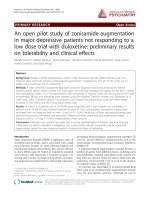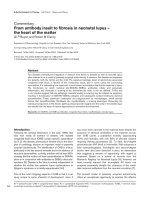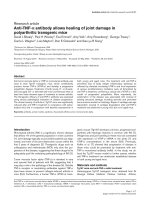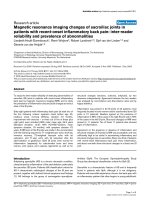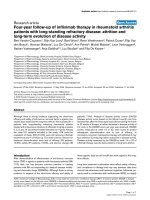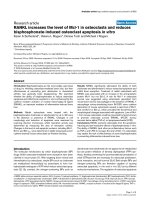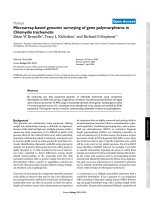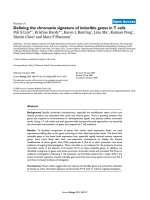Báo cáo y học: " α Anti-TNF-α antibody allows healing of joint damage in polyarthritic transgenic mice" pdf
Bạn đang xem bản rút gọn của tài liệu. Xem và tải ngay bản đầy đủ của tài liệu tại đây (1.23 MB, 7 trang )
Introduction
Rheumatoid arthritis (RA) is a significant, chronic disease
that afflicts 1% of the general population in most countries
[1]. Joint damage typically occurs before patients are diag-
nosed, and most of the joint destruction occurs within the
first 2 years of diagnosis [2]. Therapeutic drugs such as
sulfasalazine and methotrexate (MTX) only slow the pro-
gression of the disease, suggesting that these drugs fail to
adequately quell the underlying pathophysiology of RA [3].
Tumor necrosis factor alpha (TNF-α) is elevated in sera
and synovial fluid of patients with RA, suggesting that it
may play a role in the pathology of the disease [4]. Soluble
TNF-α receptor or neutralizing antibodies against TNF-α
have been shown to prevent collagen-induced arthritis in
mice [5,6]. Furthermore, a human TNF-α (hTNF-α) trans-
genic mouse (Tg197) develops a chronic, progressive pol-
yarthritis with histologic features in common with RA [7].
Weight loss and joint swelling in these mice are correlated
with expression of hTNF-α mRNA in the joints [7] and
hTNF-α concentrations in the serum [8,9]. Previously,
Keffer et al. [7] showed that progression of disease in
these mice could be prevented by treatment with anti-
TNF-α monoclonal antibody (mAb). In this study, we uti-
lized the Tg197 mouse model to further assess whether
anti-TNF-α treatment can ameliorate established disease
in both young and aged mice.
Materials and methods
Tg197 mice and anti-TNF-
αα
mAb treatment
Heterozygous Tg197 transgenic mice, obtained from Dr
George Kollias (Hellenic Pasteur Institute, Athens,
Anti-TNF-α = anti-tumor necrosis factor alpha; ELISA = enzyme-linked immunosorbent assay; hTNF-α = human tumor necrosis factor alpha; IFN =
interferon; IL = interleukin; mAb = monoclonal antibody; mRNA = messenger ribonucleic acid; MTX = methotrexate; PCR = polymerase chain
reaction; RA = rheumatoid arthritis; TNF-α = tumor necrosis factor alpha.
Available online />Research article
Anti-TNF-
αα
antibody allows healing of joint damage in
polyarthritic transgenic mice
David J Shealy
1
, Paul H Wooley
2
, Eva Emmell
1
, Amy Volk
1
, Amy Rosenberg
1
, George Treacy
1
,
Carrie L Wagner
1
, Lois Mayton
2
, Don E Griswold
1
and Xiao-yu R Song
1
1
Centocor, Inc, Malvern, Pennsylvania, USA
2
Department of Orthopaedic Surgery, Wayne State University Medical School, Detroit, Michigan, USA
Corresponding author: David J Shealy (e-mail: )
Received: 14 August 2001 Revisions received: 14 May 2002 Accepted: 20 May 2002 Published: 28 June 2002
Arthritis Res 2002, 4:R7
© 2002 Shealy et al., licensee BioMed Central Ltd (Print ISSN 1465-9905; Online ISSN 1465-9913)
Abstract
Anti-tumor-necrosis-factor-α (TNF-α) monoclonal antibody was
used to treat Tg197 transgenic mice, which constitutively
produce human TNF-α (hTNF-α) and develop a progressive
polyarthritic disease. Treatment of both young (7- or 8-week-
old) and aged (27- or 28-week-old) mice commenced when at
least two limbs showed signs of moderate to severe arthritis.
The therapeutic efficacy of anti-TNF-α antibody was assessed
using various pathological indicators of disease progression.
The clinical severity of arthritis in Tg197 mice was significantly
reduced after anti-TNF-α treatment in comparison with saline-
treated mice and in comparison with baseline assessments in
both young and aged mice. The treatment with anti-TNF-α
prevented loss of body weight. Inflammatory pathways as
reflected by elevated circulating hTNF-α and local expression
of various proinflammatory mediators were all diminished by
anti-TNF-α treatment, confirming a critical role of hTNF-α in this
model of progressive polyarthritis. More importantly, the
amelioration of the disease was associated with reversal of
existing structural damage, including synovitis and periosteal
bone erosions evident on histology. Repair of cartilage was age
dependent: reversal of cartilage degradation after anti-TNF-α
treatment was observed in young mice but not in aged mice.
Keywords: antibody, animal models, cytokines, rheumatoid arthritis, tumor necrosis factor alpha
Page 1 of 7
(page number not for citation purposes)
Page 2 of 7
(page number not for citation purposes)
Arthritis Research Vol 4 No 5 Shealy et al.
Greece) [7], were identified by PCR analysis using
primers to the 3′-modified hTNF-α gene. Two experi-
mental groups of 25 mice were used. ‘Young mice’
were enrolled into the study when they developed clini-
cal signs of arthritis at 7 or 8 weeks of age. A second
group of mice was maintained disease-free with
10 mg/kg of anti-TNF-α mAb weekly starting at 4 weeks
of age; when they reached 24 weeks of age, the treat-
ment was stopped and these ‘aged mice’ were allowed
to develop arthritis before they were enrolled into the
study. The enrollment criteria for both young and aged
mice required them to have a clinical score of at least 2
on two limbs. The experimental protocols were
approved by Centocor’s Institutional Animal Care and
Use Committee.
The murine anti-TNF-α mAb used in this study binds with
high affinity to hTNF-α and prevents binding to the TNF
receptor [10]. Anti-TNF-α mAb was administered by
intraperitoneal injection at 10 mg/kg weekly and the
animals in the control group received weekly injections of
saline.
Clinical scores
Clinical scores were based on a previously described
scoring system [11] modified as follows: 0 (normal), 1
(edema or distortion of paw or ankle joints), 2 (distortion of
paw and ankle joints), or 3 (ankylosis of wrist or ankle
joints). The sum of all four paws was scored weekly, with a
maximum possible score of 12 per mouse.
Histologic processing of joints
Specimens were processed and scored as described pre-
viously [12,13] and in the supplementary material.
ELISA assay
Serum samples were separated from whole blood, which
was collected by intracardiac puncture at baseline and at
3, 6, and 16 weeks post-treatment. Serum levels of
hTNF-α were determined by ELISA at a 1:2 dilution
according to the manufacturer’s instructions (Biosource
International, Camarillo, CA, USA).
RNA isolation and RNase protection assay
Samples were prepared as described in the Supplemen-
tary material and analyzed in an RNase protection assay
according to the manufacturer’s instructions (PharMingen,
San Diego, CA, USA).
Statistical analysis
All data are expressed as means ± standard deviation
unless noted otherwise. Statistical significance was tested
using analysis of variance for multiple groups. If significant
differences were found, pair-wise testing was performed
using Tukey’s test. The level of significance for all compar-
isons was set at P < 0.05.
Results
Amelioration of established polyarthritis by treatment
with anti-TNF-
αα
mAb
Increased cartilage turnover and repair in response to
insult has been observed in young mice, whereas aged
mice show decreased cartilage turnover after closure of
the growth plate [14]. Therefore, anti-TNF-α treatment
was evaluated in both young (7–8-week-old) and aged
(27–28-week-old) Tg197 mice with established arthritis.
The mean clinical arthritis score at baseline was 6 (Fig. 1),
indicating arthritis was established at the commencement
of treatment. The clinical arthritis score increased progres-
sively in the saline-treated group and these mice were
humanely killed at 6 weeks. In contrast, the clinical arthritic
score was markedly decreased in the groups, both young
and aged, treated with anti-TNF-α, indicating a marked
suppression of their arthritic symptoms (Fig. 1a,b). Mice in
the saline-treated group progressively lost weight,
whereas mice in the anti-TNF-α group showed a signifi-
cant weight gain throughout the study (see Supplemen-
tary Fig. 1). The arthritic score (weeks 1 to 16
post-treatment; Fig. 1a,b) and weight gain (weeks 5 to 16
post-treatment; Supplementary Fig. 1) in the group treated
with anti-TNF-α were significantly improved in comparison
with the saline-treated group in both young and aged
mice. More importantly, the arthritic scores for the group
treated with anti-TNF-α were significantly improved in
comparison with the baseline score from weeks 4 through
16 in both young and aged mice (Fig. 1a,b). These results
indicate that disease progression was not just prevented
but was reversed following anti-TNF-α treatment.
Effects of treatment with anti-TNF-
αα
mAb on joint
histopathology
All joints were scored in a blinded fashion for synovitis,
bone erosions, and cartilage degradation using a prede-
fined scoring system. The mean histologic scores for each
treatment group at various time points are shown in Fig. 2.
Saline treatment was followed by increased histologic
scores for synovitis, bone erosions, and cartilage damage
relative to that observed at baseline. Anti-TNF-α treatment
for 6 weeks significantly reduced all three histologic
scores relative to the baseline score in young mice (Fig. 2)
and two of the three histologic scores in aged mice (Sup-
plementary Fig. 2). After 16 weeks of anti-TNF-α treat-
ment, synovial inflammation and bone erosions were
almost completely resolved in both young and aged mice,
and a significant reduction in cartilage degradation in
comparison with baseline was maintained in young mice.
Cartilage degradation in aged mice treated with anti-
TNF-α was similar to that at the baseline measurement
and significantly lower than that in the saline treatment
group (Supplementary Fig. 2).
Representative tissue sections of the ankle joints from
young mice are shown in Fig. 3. Evidence of arthritic
Page 3 of 7
(page number not for citation purposes)
disease was readily observed at baseline (Fig. 3a,b), and
the disease continued to progress in saline-treated mice at
6 weeks, with increased cell proliferation and inflammatory
cell infiltration, erosion of cartilage and bone, and loss of
proteoglycan from the cartilage (Fig. 3c,d). However, after
6 weeks of anti-TNF-α treatment, improvements in all
histopathological parameters were observed with both
staining procedures (Fig. 3e,f). No visible evidence of bone
or cartilage erosion was observed and all signs of cellular
proliferation and infiltration disappeared. The proteoglycan
content of the cartilage was notably improved. Extended
treatment with anti-TNF-α (for 16 weeks) maintained
normal joint architecture (data not shown). These results
demonstrate that blocking hTNF-α reverses joint inflamma-
tion and promotes joint healing in this model of polyarthritis.
Inhibition of TNF-
αα
and other proinflammatory
cytokines
To define the underlying mechanisms by which anti-TNF-α
mAb ameliorated joint inflammation and structural damage,
the levels of various proinflammatory mediators were exam-
ined. First, circulating hTNF-α levels as detected by ELISA
were more than halved as early as 3 weeks and the reduc-
tion was sustained for 16 weeks after treatment with anti-
TNF-α mAb in comparison with saline-treated animals
(Fig. 4a). In addition, murine IL-6, IL-1β, and IFN-γ mRNA,
which are expressed in the arthritic joint tissues, were
clearly diminished following anti-TNF-α treatment when
total joint RNA was examined by RNase protection assays
(see Supplementary Fig. 3). When the levels of murine IL-6,
Available online />Figure 1
Treatment with anti-TNF-α monoclonal antibodies reverses established
arthritis in Tg197 mice. (a) Young mice (at 7 to 8 weeks of age) or (b)
aged mice (at 27 to 28 weeks of age) with established arthritis were
randomized to three groups to be humanely killed immediately
(baseline, open square, n = 5) or to receive weekly doses of saline
(open circle, n = 10) or 10 mg/kg of anti-TNF-α (closed square, n =10
through 6 weeks of age and n = 5 from 7 to 16 weeks). The mice were
monitored weekly for arthritic score. *P < 0.05, versus saline-treated
controls;
+
P < 0.05, versus baseline score; both scores remaining
significant until the end of the study. Data are from two experiments.
TNF, tumor necrosis factor.
Figure 2
Synovitis, bone erosion, and cartilage degradation histology scores in
young Tg197 mice. Joint tissues were harvested at baseline (n = 5) and
after 6 weeks of saline treatment (n = 10) or 6 weeks (n = 5) or 16
weeks (n = 5) of treatment with anti-TNF-α monoclonal antibodies. All
paws were subjected to blinded histologic analysis. *P < 0.05, versus
baseline. mAb, monoclonal antibody; TNF, tumor necrosis factor.
IL-1β, and IFN-γ mRNA were standardized to glyceralde-
hyde-3-phosphate dehydrogenase (GAPDH) (Fig. 4b–d), a
2–3-fold reduction in murine IL-6 and IFN-γ was observed
in the aged animals treated with anti-TNF-α in comparison
with those treated with saline at 6 weeks post-treatment
(Fig. 4b,c). Interestingly, local expression of murine TNF-α
mRNA was not affected by treatment with anti-TNF-α anti-
bodies, suggesting that hTNF-α plays a crucial role in the
pathogenesis of arthritis in this model.
Discussion
Currently, MTX is the most widely used disease-modifying
antirheumatic drug for the treatment of RA. However, MTX
treatment rarely results in complete disease remission [15]
and only slows the progression of joint erosion [16]. In
addition, long-term treatment with MTX is associated with
pulmonary [17] and liver toxicities [18] and other side
effects. Therefore, a treatment option that facilitates rever-
sal of joint damage and has longer effectiveness and
fewer side effects is desirable.
Experimental arthritis models have contributed to the basic
understanding of joint disease and to the development of
effective antiarthritic agents [19]. Several models have
been used to mimic human RA, ranging from immunization
with cartilage components to infection with joint trophic
organisms [20,21]. Blocking TNF-α [6,22] or IL-1 [23,24]
in these models has routinely shown benefit, although
some questions remain regarding the role of these
cytokines in mitigating joint inflammation versus preventing
cartilage degradation and bone erosion [25].
Using the Tg197 mice, we have shown that maintenance
anti-TNF-α therapy, initiated after joint inflammation and
erosions have occurred, allows damaged joints to heal.
Specifically, anti-TNF-α mAb proved equally effective in
reversing joint synovitis and erosions both in young mice,
where an active repair process to damage occurs, and
aged mice, where the repair process has relatively slowed.
However, the repair of cartilage damage was different
between young and aged mice. Cartilage in young mice
treated with anti-TNF-α was significantly improved relative
to saline-treated and baseline mice. By comparison, treat-
ment of aged mice with anti-TNF-α prevented further carti-
lage damage but did not improve histological scores
relative to baseline values. Mechanistically, the therapeutic
effect of anti-TNF-α appears to be due to either neutraliza-
tion of soluble hTNF-α or inhibition of hTNF-α production in
the diseased joint. Additionally, other proinflammatory
cytokine mRNAs were decreased in the local diseased
tissues either through suppression of inflammatory cell infil-
tration or inhibition of cytokine production. Moreover, anti-
TNF-α treatment resulted in a modest inhibition of murine
IL-1β production in the diseased joint, which is consistent
with previous findings that anti-TNF-α antibody inhibits the
generation of IL-1 in collagen-induced arthritis and IL-1, IL-
6, and IL-8 in rheumatoid synovial cultures [26,27]. Our
study provides preclinical evidence supporting the use of
anti-TNF-α mAb in ameliorating arthritic pathology.
The progressive arthritis observed in Tg197 mice is similar
to the pathology in patients with RA. Recent clinical data
indicate that the blockade of TNF-α significantly reduces
the signs and symptoms of RA [28,29] and inhibits the pro-
gression of structural damage [30,31]. It remains to be
seen whether extended anti-TNF-α therapy might permit
regeneration of articular cartilage and bone in established
human disease, where multiple etiological pathways may
contribute to the RA disease syndrome [32,33]. Neverthe-
less, it is likely that much of the RA pathology involves TNF-
α activation, and the results from the Tg197 model provide
a sound scientific rationale for the therapeutic benefits
observed following anti-TNF-α treatment in RA patients.
Arthritis Research Vol 4 No 5 Shealy et al.
Page 4 of 7
(page number not for citation purposes)
Figure 3
Histology shows significant healing of arthritic joints in young Tg197
mice after treatment with anti-TNF-α mAb. Tissue sections of the ankle
joints were obtained from young Tg197 mice with established arthritis
at baseline (a,b) and after 6 weeks of treatment with saline (c,d) or
anti-TNF-α (e,f). Sections were stained with hematoxylin and eosin (a,
c, e) or toluidine blue (b, d, f). The arrows in panels (a) and (b) indicate
areas of cell infiltration (1), erosions (2) and loss of proteoglycan from
cartilage (3). Original magnification, 20×. mAb, monoclonal antibody;
TNF, tumor necrosis factor.
Conclusion
Progression of established polyarthritis in the Tg197
hTNF-α transgenic mouse can be reversed by treatment
with anti-TNF-α mAb, as shown by significant improve-
ment in clinical and histological scores.
Acknowledgments
The authors thank Dr George Kollias for providing the Tg197 trans-
genic breeder mice and Dr Bernie Scallon for polymerase chain reac-
tion analysis of the Tg197 mice.
References
1. Alarcon GS: Epidemiology of rheumatoid arthritis. Rheum Dis
Clin North Am 1995, 21:589-604.
2. van der Heijde DM: Joint erosions and patients with early
rheumatoid arthritis. Br J Rheumatol 1995, 34(suppl 2):74-78.
3. Weinblatt ME: Rheumatoid arthritis: treat now, not later! Ann
Intern Med 1996, 124:773-774.
4. Feldmann M, Maini, RN: Anti-TNF alpha therapy of rheumatoid
arthritis: what have we learned? Annu Rev Immunol 2001, 19:
163-196.
5. Piguet PF, Grau GE, Vesin C, Loetscher H, Gentz R, Lesslauer W:
Evolution of collagen arthritis in mice is arrested by treatment
with anti-tumour necrosis factor (TNF) antibody or a recombi-
nant soluble TNF receptor. Immunology 1992, 77:510-514.
6. Williams RO, Feldmann M, Maini RN: Anti-tumor necrosis factor
ameliorates joint disease in murine collagen-induced arthritis.
Proc Natl Acad Sci USA 1992, 89:9784-9788.
7. Keffer J, Probert L, Cazlaris H, Georgopoulos S, Kaslaris E, Kious-
sis D, Kollias G: Transgenic mice expressing human tumour
necrosis factor: a predictive genetic model of arthritis. EMBO
J 1991, 10:4025-4031.
8. Probert L, Plows D, Kontogeorgos G, Kollias G: The type I inter-
leukin-1 receptor acts in series with tumor necrosis factor
(TNF) to induce arthritis in TNF-transgenic mice. Eur J
Immunol 1995, 25:1794-1797.
9. Butler DM, Malfait AM., Mason LJ, Warden PJ, Kollias G, Maini
RN, Feldmann M, Brennan FM: DBA/1 mice expressing the
human TNF-
αα
transgene develop a severe, erosive arthritis:
characterization of the cytokine cascade and cellular compo-
sition. J Immunol 1997, 159:2867-2876.
10. Knight DM, Trinh H, Le J, Siegel S, Shealy D, McDonough M,
Scallon B, Moore MA, Vilcek J, Daddona P, Ghrayeb J: Construc-
tion and initial characterization of a mouse-human chimeric
anti-TNF antibody. Mol Immunol 1993, 30:1443-1453.
11. Miotla J, Maciewicz R, Kendrew J, Feldmann M, Paleolog E: Treat-
ment with soluble VEGF receptor reduces disease severity in
murine collagen-induced arthritis. Lab Invest 2000, 80:1195-
1205.
12. Wooley PH: Collagen-induced arthritis in the mouse. Methods
Enzymol 1988, 162:361-373.
13. Wooley PH, Luthra HS, Stuart JM, David CS: Type II collagen-
induced arthritis in mice. I. Major histocompatibility complex (I
region) linkage and antibody correlates. J Exp Med 1981, 154:
688-700.
14. Alini M, Matsui Y, Dodge GR, Poole AR: The extracellular matrix
of cartilage in the growth plate before and during calcification:
changes in composition and degradation of type II collagen.
Calcif Tissue Int 1992, 50:327-335.
Available online />Page 5 of 7
(page number not for citation purposes)
Figure 4
Treatment with anti-TNF-α monoclonal antibodies inhibits proinflammatory cytokine production in Tg197 mice. (a) Sera were collected from young
animals at the indicated times. Levels of hTNF-α were determined by ELISA and expressed as mean ± SEM of each group. (b–d) Detection of
proinflammatory cytokines, murine IL-6, IFN-γ, and IL-1β mRNA in joint tissue of aged mice. RNA was extracted from the joint tissues of the mice at
baseline and 6 weeks after treatment with either saline or anti-TNF-α mAb. An RNase protection assay was then performed. The ratios of individual
cytokine mRNA to GAPDH in animals treated with anti-TNF-α mAb are compared with those in saline-treated animals or animals at baseline.
GAPDH, glyceraldehyde-3-phosphate dehydrogenase; mAb, monoclonal antibody; TNF, tumor necrosis factor.
15. Weinblatt ME, Weissman BN, Holdsworth DE, Fraser PA, Maier
AL, Falchuk KR, Coblyn JS: Long-term prospective study of
methotrexate in the treatment of rheumatoid arthritis. 84-
month update. Arthritis Rheum 1992, 35:129-137.
16. Weinblatt ME, Polisson R, Blotner SD, Sosman JL, Aliabadi P,
Baker N, Weissman BN: The effects of drug therapy on radi-
ographic progression of rheumatoid arthritis. Results of a 36-
week randomized trial comparing methotrexate and
auranofin. Arthritis Rheum 1993, 36:613-619.
17. Alarcon GS, Kremer JM, Macaluso M, Weinblatt ME, Cannon
GW, Palmer WR, St Clair EW, Sunday JS, Alexander RW, Smith
GJ, Axiotis CA: Risk factors for methotrexate-induced lung
injury in patients with rheumatoid arthritis. A multicenter,
case-control study. Methotrexate-Lung Study Group. Ann
Intern Med 1997, 127:356-364.
18. Kremer JM, Furst DE, Weinblatt ME, Blotner SD: Significant
changes in serum AST across hepatic histological biopsy
grades: prospective analysis of 3 cohorts receiving
methotrexate therapy for rheumatoid arthritis. J Rheumatol
1996, 23:459-461.
19. Griffiths RJ. The use of animals in the search for anti-inflam-
matory drugs. In Mechanisms and Models in Rheumatoid Arthri-
tis. Edited by Henderson B, Edwards JCW, Pettipher ER. London:
Academic Press; 1995:527-537.
20. Wooley PH: Animal models of rheumatoid arthritis. Curr Opin
Rheumatol 1991, 3:407-420.
21. Burkhardt H, Kalden JR: Animal models of autoimmune dis-
eases. Rheumatol Int 1997, 17:91-99.
22. Wooley PH, Dutcher J, Widmer MB, Gillis S: Influence of a
recombinant human soluble tumor necrosis factor receptor
FC fusion protein on type II collagen-induced arthritis in mice.
J Immunol 1993, 151:6602-6607.
23. Wooley PH, Whalen JD, Chapman DL, Berger AE, Richard KA,
Aspar DG, Staite ND: The effect of an interleukin-1 receptor
antagonist protein on type II collagen-induced arthritis and
antigen-induced arthritis in mice. Arthritis Rheum 1993, 36:
1305-1314.
24. van den Berg WB, Joosten LA, Helsen M, van de Loo FA: Amelio-
ration of established murine collagen-induced arthritis with
anti-IL-1 treatment. Clin Exp Immunol 1994, 95:237-243.
25. Joosten LA, Helsen MM, Saxne T, van de Loo FA, Heinegard D,
van den Berg WB: IL-1 alpha beta blockade prevents cartilage
and bone destruction in murine type II collagen-induced
arthritis, whereas TNF-alpha blockade only ameliorates joint
inflammation. J Immunol 1999, 163:5049-5055.
26. Feldmann M, Brennan FM, Maini RN: Role of cytokines in
rheumatoid arthritis. Annu Rev Immunol 1996, 14: 397-440.
27. Williams RO, Marinova-Mutafchieva L, Feldmann M, Maini RN:
Evaluation of TNF
αα
and IL-1 blockade in collagen-induced
arthritis and comparison with combined anti-TNF
αα
/anti-CD4
therapy. J Immunol 2000, 165:7240-7245.
28. Moreland LW, Schiff MH, Baumgartner SW, Tindall EA, Fleis-
chmann RM, Bulpitt KJ, Weaver AL, Keystone EC, Furst DE,
Mease PJ, Ruderman EM, Horwitz DA, Arkfeld DG, Garrison L,
Burge DJ, Blosch CM, Lange ML, McDonnell ND, Weinblatt ME:
Etanercept therapy in rheumatoid arthritis. A randomized,
controlled trial. Ann Intern Med 1999, 130:478-486.
29. Maini R, St Clair EW, Breedveld F, Furst D, Kalden J, Weisman M,
Smolen J, Emery P, Harriman G, Feldmann M, Lipsky P: Infliximab
(chimeric anti-tumour necrosis factor
αα
monoclonal antibody)
versus placebo in rheumatoid arthritis patients receiving con-
comitant methotrexate: a randomised phase III trial. ATTRACT
Study Group. Lancet 1999, 354:1932-1939.
30. Lipsky PE, van der Heijde DM, St Clair EW, Furst DE, Breed-
veld FC, Kalden JR, Smolen JS, Weisman M, Emery P, Feld-
mann M, Harriman GR, Maini RN: For the Anti-Tumor
Necrosis Factor Trial in Rheumatoid Arthritis with Concomi-
tant Therapy Study Group. Infliximab and methotrexate in
the treatment of rheumatoid arthritis. N Engl J Med 2000,
343:1594-1602.
31. Bathon JM, Martin RW, Fleischmann RM, Tesser JR, Schiff MH,
Keystone EC, Genovese MC, Wasko MC, Moreland LW, Weaver
AL, Markenson J, Finck BK: A comparison of etanercept and
methotrexate in patients with early rheumatoid arthritis. N
Engl J Med 2000, 343:1586-1593.
32. Breedveld FC: New insights in the pathogenesis of rheuma-
toid arthritis. J Rheumatol 1998, 25(suppl 53):3-7.
33. Smolen JS, Tohidast-Akrad M, Gal A, Kunaver M, Eberl G, Zenz P,
Falus A, Steiner G: The role of T-lymphocytes and cytokines in
rheumatoid arthritis. Scand J Rheumatol 1996, 25:1-4.
Correspondence
David J Shealy, PhD, 200 Great Valley Parkway, Malvern, PA 19355-
1307, USA. Tel: +1 (610) 889 4536; fax: +1 (610) 651 6798; e-mail:
Supplementary material
Supplementary materials and methods
Histologic processing of joints
Joint tissues from wrists, ankles, elbows, and knees were
fixed in 10% buffered formalin overnight, decalcified in
10% formic acid for 18 days, dehydrated, and then
embedded in paraffin. Specimens were cut longitudinally
to the midline, and 5-µm sections mounted for staining
with hematoxylin and eosin or toluidine blue. Joint sections
stained with hematoxylin and eosin were scored for syn-
ovitis and bone erosions, as described elsewhere [12,13].
Sections stained with toluidine blue were scored for carti-
lage degradation (0, normal staining; 1, some loss of stain-
Arthritis Research Vol 4 No 5 Shealy et al.
Page 6 of 7
(page number not for citation purposes)
Supplementary Figure 1
Anti-TNF-α treatment reverses weight loss in arthritic animals. (a)
Young (at 7 to 8 weeks of age) or (b) aged mice (at 27 to 28 weeks of
age) with established arthritis (arthritic score of 2 in at least two limbs)
were randomized to three groups to be humanely killed immediately
(baseline, n = 5) or to receive weekly doses of saline (open circle,
n = 10) or 10 mg/kg of anti-TNF-α (closed square, n = 10 through
6 weeks and n = 5 from 7 to 16 weeks). Weight gain was measured
as change from pretreatment weight. *P < 0.05, versus saline controls,
and remained significant until the end of the study. TNF, tumor
necrosis factor.
ing; 2, moderate loss of staining; 3, weak staining; 4, very
weak staining; 5, no visible staining). Specimens were
examined using light microscopy and scored in a blinded
fashion with regard to treatment.
RNA isolation and RNase protection assay
Excised ankle and paw joints were immediately frozen in
liquid nitrogen and processed in a freezer/mill (SPEX Certi-
Prep, Metuchen, NJ, USA) with liquid nitrogen at 2-minute
pulses. RNA was isolated from 50 mg of the joint powder
with 1 ml Trizol reagent according to the manufacturer’s
instructions (Gibco BRL, Grand Island, NY, USA). RNA
was extracted with 0.2 ml chloroform, precipitated with
0.5 ml isopropyl alcohol, and resuspended in 30 µl diethyl
pyrocarbonate-treated water. Ten micrograms of total RNA
from each sample was used for RNase protection assay
(mCK –2b and –3b Multi-Probe Template Sets, PharMin-
gen, San Diego, CA, USA), exposed to a Phosphor screen,
and quantified by a Phosphorimager with the use of Image
Quant software (Molecular Dynamics, Sunnyvale, CA,
USA). The signal-intensity ratio of different cytokine mes-
senger RNA (mRNA) to GAPDH was determined.
Available online />Page 7 of 7
(page number not for citation purposes)
Supplementary Figure 2
Histology scores for synovitis, bone erosion, and cartilage degradation
in aged mice. Joint tissues were harvested at baseline (n = 5), after 6
weeks of saline treatment (n = 10), or after 6 weeks (n = 5) or 16
weeks (n = 5) of anti-TNF-α treatment. All paws were subjected to
blinded histologic analysis. *P < 0.05, versus baseline;
+
P < 0.05,
versus saline-treated controls. mAb, monoclonal antibody; TNF, tumor
necrosis factor.
Supplementary Figure 3
Detection of mRNA of proinflammatory cytokines murine TNF-α, IL-6,
and IFN-γ in joint tissue of aged mice. RNA was extracted from the
paw joints at baseline and after 6 weeks of treatment with saline or
anti-TNF-α. An RNase protection assay was then performed. GAPDH,
glyceraldehyde-3-phosphate dehydrogenase; L32, ribosomal protein;
TNF, tumor necrosis factor.


